British Overseas Territories
British Overseas Territories | |
|---|---|
 Flag of the United Kingdom | |
 Location of the United Kingdom and the British Overseas Territories | |
| Largest settlements | George Town, Gibraltar, Road Town |
| Official language | English |
| Demonym | British, Briton |
| Territories | 14 territories
|
| Leaders | |
• Monarch | Elizabeth II |
• Foreign Secretary | Jeremy Hunt |
• Minister of State | Tariq Ahmad |
• Minister of State | Alan Duncan |
| Area | |
• Total | 1,727,570 km2 (667,020 sq mi) |
| Population | |
• 2010 estimate | 250,000 |
| Date format | dd/mm/yyyy (AD) |
The British Overseas Territories (BOTs) or United Kingdom Overseas Territories (UKOTs) are 14 territories under the jurisdiction and sovereignty of the United Kingdom.[1][2] They are the parts of the British Empire that have not been granted independence or have voted to remain British territories. These territories do not form part of the United Kingdom and, with the exception of Gibraltar, are not part of the European Union. Most of the permanently inhabited territories are internally self-governing, with the UK retaining responsibility for defence and foreign relations. Three are inhabited only by a transitory population of military or scientific personnel. They all share the British monarch (Elizabeth II) as head of state.
As of April 2018[update] the Minister responsible for the Territories excluding the Falkland Islands, Gibraltar and the Sovereign Base Areas on Cyprus, is Tariq Ahmad, Minister of State for the Commonwealth and the UN. The other three territories are the responsibility of Sir Alan Duncan MP, Minister of State for Europe and the Americas.[3]
Contents
1 Current overseas territories
1.1 Map
2 Collective titles
3 Population
4 History
5 Government
5.1 Head of state
5.2 Local government
5.3 Legal system
5.4 Joint Ministerial Council
6 Relations with the United Kingdom
6.1 Foreign affairs
6.2 Citizenship
6.3 Military
7 Languages
8 Currencies
9 Symbols and insignia
10 Sports
11 Biodiversity
12 See also
13 References
14 Further reading
15 External links
Current overseas territories
The fourteen British Overseas Territories are:[4]
| Flag | Arms | Name | Location | Motto | Area | Population | Capital |
|---|---|---|---|---|---|---|---|
Akrotiri and Dhekelia | Cyprus, Mediterranean Sea | 255 km2 (98 sq mi)[5] | 7,700 (Cypriots; estimate) 8,000 non-permanent (UK military personnel and their families; estimate) | Episkopi Cantonment | |||
Anguilla | Caribbean, North Atlantic Ocean | "Strength and Endurance" | 91 km2 (35.1 sq mi)[6] | 13,500 (2006 estimate)[7] | The Valley | ||
Bermuda | North Atlantic Ocean between the Azores, the Caribbean, Cape Sable Island and Canada | "Quo fata ferunt" (Latin; "Whither the Fates carry [us]") | 54 km2 (20.8 sq mi)[8] | 64,000 (2007 estimate)[9] | Hamilton | ||
British Antarctic Territory | Antarctica | "Research and discovery" | 1,709,400 km2 (660,000 sq mi)[6] | 0 50 non-permanent in winter, over 400 in summer (research personnel)[10] | Rothera (main base) | ||
British Indian Ocean Territory | Indian Ocean | "In tutela nostra Limuria" (Latin; "Limuria is in our charge") | 46 km2 (18 sq mi)[11] | 0 3,000 non-permanent (UK and US military and staff personnel; estimate)[12] | Diego Garcia (base) | ||
British Virgin Islands | Caribbean, North Atlantic Ocean | "Vigilate" (Latin; "Be watchful") | 153 km2 (59 sq mi)[13] | 27,000 (2005 estimate)[13] | Road Town | ||
Cayman Islands | Caribbean | "He hath founded it upon the seas" | 264 km2 (101.9 sq mi)[14] | 56,092 (2013 estimate)[14] | George Town | ||
Falkland Islands | South Atlantic Ocean | "Desire the right" | 12,173 km2 (4,700 sq mi)[8] | 2,955 (2006 census)[15] 1,350 non-permanent (UK military personnel; 2012 estimate) | Stanley | ||
Gibraltar | Iberian Peninsula, Continental Europe | "Nulli expugnabilis hosti" (Latin; "No enemy shall expel us") | 6.5 km2 (2.5 sq mi)[16] | 28,800 (2005 estimate)[17] 1,250 non-permanent (UK military personnel; 2012 estimate) | Gibraltar | ||
Montserrat | Caribbean, North Atlantic Ocean | "A people of excellence, moulded by nature, nurtured by God" | 101 km2 (39 sq mi)[18] | 4,655 (2006 estimate)[18] | Plymouth (abandoned due to volcano—de facto capital is Brades) | ||
Pitcairn, Henderson, Ducie and Oeno Islands | Pacific Ocean | 47 km2 (18 sq mi)[19] | 49 (2014 estimate)[20] 6 non-permanent (2014 estimate)[21] | Adamstown | |||
Saint Helena, Ascension and Tristan da Cunha, including: | South Atlantic Ocean | 420 km2 (162 sq mi) | 5,530 (total; estimate) | Jamestown | |||
Saint Helena | "Loyal and Unshakeable" (Saint Helena) | 4,255 (Saint Helena; 2008 census)[22] | |||||
Ascension Island | 880 (Ascension; estimate)[23] 1,000 non-permanent (Ascension; UK military personnel; estimate)[23] | ||||||
Tristan da Cunha | "Our faith is our strength" (Tristan da Cunha) | 300 (Tristan da Cunha; estimate)[23] 9 non-permanent (Tristan da Cunha; weather personnel) | |||||
South Georgia and the South Sandwich Islands | South Atlantic Ocean | "Leo terram propriam protegat" (Latin; "Let the lion protect his own land") | 4,066 km2 (1,570 sq mi)[24] | 0 99 non-permanent (officials and research personnel)[25] | King Edward Point | ||
Turks and Caicos Islands | Lucayan Archipelago, North Atlantic Ocean | 430 km2 (166 sq mi)[26] | 32,000 (2006 census)[26] | Cockburn Town | |||
| Overall | 1,727,570 km2 | c. 250,000 |
Map
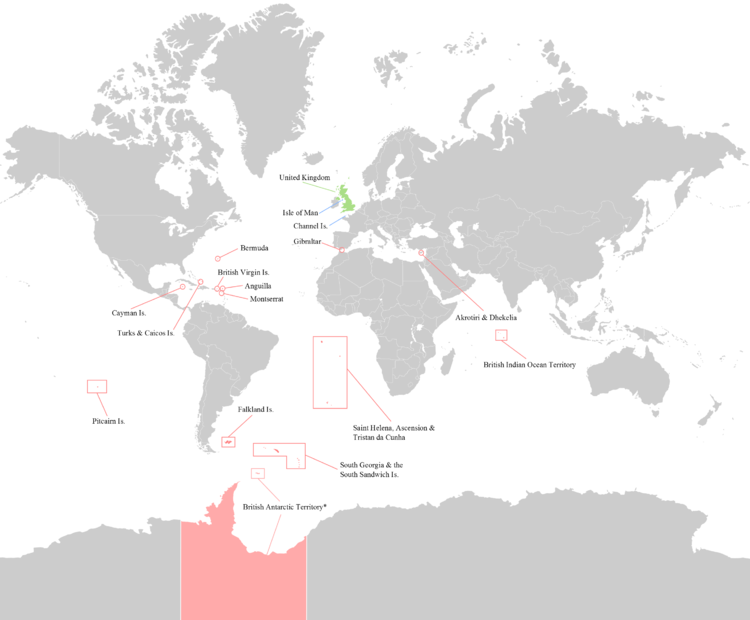
British Overseas Territories
United Kingdom
Crown dependencies
Collective titles

Unofficial flag for the overseas territories used by Friends of the British Overseas Territories, a charitable organisation.[27]
The term "British Overseas Territory" was introduced by the British Overseas Territories Act 2002, replacing the term British Dependent Territory, introduced by the British Nationality Act 1981. Prior to 1 January 1983, the territories were officially referred to as British Crown Colonies.
Although the Crown dependencies of Jersey, Guernsey, and the Isle of Man are also under the sovereignty of the British monarch, they are in a different constitutional relationship with the United Kingdom.[28][29] The British Overseas Territories and Crown Dependencies are themselves distinct from the Commonwealth realms, a group of 16 independent countries (including the United Kingdom) each having Elizabeth II as their reigning monarch, and from the Commonwealth of Nations, a voluntary association of 52 countries mostly with historic links to the British Empire (which also includes all Commonwealth realms).
Population
With the exceptions of the British Antarctic Territory and South Georgia and the South Sandwich Islands (which host only officials and research station staff) and the British Indian Ocean Territory (used as a military base), the Territories retain permanent civilian populations. Permanent residency for the approximately 7,000 civilians living in the Sovereign Base Areas of Akrotiri and Dhekelia is limited to citizens of the Republic of Cyprus.
Collectively, the Territories encompass a population of about 250,000 people and a land area of about 1,727,570 square kilometres (667,020 sq mi). The vast majority of this land area, 1,700,000 square kilometres (660,000 sq mi), constitutes the almost uninhabited British Antarctic Territory, while the largest territory by population, Bermuda, accounts for almost a quarter of the total BOT population. At the other end of the scale, three territories have no civilian population; the Antarctic territory, the British Indian Ocean Territory (from which the Chagos Islanders were controversially removed) and South Georgia. Pitcairn Islands, settled by the survivors of the Mutiny on the Bounty, is the smallest settled territory with 49 inhabitants, while the smallest by land area is Gibraltar on the southern tip of the Iberian peninsula.[30][31] The United Kingdom participates in the Antarctic Treaty System[32] and, as part of a mutual agreement, the British Antarctic Territory is recognised by four of the six other sovereign nations making claims to Antarctic territory.
History
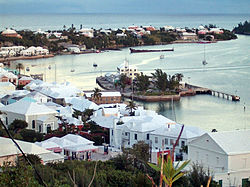
St. George's town, in the Islands of Bermuda, or "The Somers Isles". The colony was founded by the wrecking of the flagship of the Virginia Company in 1609. The Company's charter was extended to include Bermuda in 1612, and it has remained a British colony ever since. Since the rebellion of Virginia, it has been the oldest-remaining British colony, and the town of St. George's is the oldest continuously inhabited British settlement in the New World.[33]
Early colonies, in the sense of English subjects residing in lands hitherto outside the control of the English government, were generally known as "Plantations".
The first, unofficial, colony was Newfoundland, where English fishermen routinely set up seasonal camps in the 16th century.[34] It is now a province of Canada known as Newfoundland and Labrador. It retains strong cultural ties with Britain.
English colonisation of North America began officially in 1607 with the settlement of Jamestown, the first successful permanent colony in Virginia (a term that was then applied generally to North America). Its offshoot, Bermuda, was settled inadvertently after the wrecking of the Virginia company's flagship there in 1609, with the Virginia Company's charter extended to officially include the archipelago in 1612. St. George's town, founded in Bermuda in that year, remains the oldest continuously inhabited British settlement in the New World (with some historians stating that – its formation predating the 1619 conversion of "James Fort" into "Jamestown" – St. George's was actually the first successful town the English established in the New World). Bermuda and Bermudians have played important, sometimes pivotal, but generally underestimated or unacknowledged roles in the shaping of the English and British trans-Atlantic Empires. These include maritime commerce, settlement of the continent and of the West Indies, and the projection of naval power via the colony's privateers, among other areas.[35][36]
The growth of the British Empire in the 19th century, to its territorial peak in the 1920s, saw Britain acquire nearly one quarter of the world's land mass, including territories with large indigenous populations in Asia and Africa. From the mid-nineteenth century to the early twentieth century, the larger settler colonies – in Canada, Australia, New Zealand and South Africa – first became self-governing colonies and then achieved independence in all matters except foreign policy, defence and trade. Separate self-governing colonies federated to become Canada (in 1867), Australia (in 1901), South Africa (in 1910), and Rhodesia (in 1965). These and other large self-governing colonies had become known as Dominions by the 1920s. The Dominions achieved almost full independence with the Statute of Westminster (1931).

Many of the overseas territories are in the Caribbean, as shown on the map.
Through a process of decolonisation following the Second World War, most of the British colonies in Africa, Asia and the Caribbean gained independence. Some colonies became Commonwealth realms, retaining the British monarch as their own head of state.[37] Most former colonies and protectorates became member states of the Commonwealth of Nations, a non-political, voluntary association of equal members, comprising a population of around 2.2 billion people.[38]
After the independence of Southern Rhodesia (now Zimbabwe) in Africa in 1980 and British Honduras (now Belize) in Central America in 1981, the last major colony that remained was Hong Kong, with a population of over 5 million.[39] With 1997 approaching, the United Kingdom and China negotiated the Sino-British Joint Declaration, which led to the whole of Hong Kong becoming a "special administrative region" of China in 1997, subject to various conditions intended to guarantee the preservation of Hong Kong's capitalist economy and its way of life under British rule for at least 50 years after the handover. George Town in the Cayman Islands has consequently become the largest city in the Overseas Territories.
In 2002, the British Parliament passed the British Overseas Territories Act 2002. This reclassified the UK's dependent territories as overseas territories and, with the exception of those people solely connected with the Sovereign Base Areas of Cyprus, restored full British citizenship to their inhabitants.[40]
Government

McKeeva Bush, Premier of the Cayman Islands in 2012
Head of state
The head of state in the overseas territories is the British monarch, Elizabeth II. The Queen's role in the territories is in her role as Queen of the United Kingdom, and not in right of each territory.[citation needed] The Queen appoints a representative in each territory to exercise her executive power. In territories with a permanent population, a Governor is appointed by the Queen on the advice of the British Government, usually a retired senior military officer,[citation needed] or a senior civil servant. In territories without a permanent population, a Commissioner is usually appointed to represent the Queen. Exceptionally, in the oversea territory of Saint Helena, Ascension and Tristan da Cunha, an Administrator is appointed to be the Governor's representative in each of the two distant parts of the territory, namely Ascension Island and Tristan da Cunha.
The role of the Governor is to act as the de facto head of state, and they are usually responsible for appointing the head of government, and senior political positions in the territory. The Governor is also responsible for liaising with the UK Government, and carrying out any ceremonial duties. A Commissioner has the same powers as a Governor, but also acts as the head of government.[citation needed]
Local government
All the overseas territories have their own system of government, and localised laws. The structure of the government appears to be closely correlated to the size and political development of the territory.[citation needed]
| Territories | Government |
|---|---|
| There is no native or permanent population; therefore there is no elected government. The Commissioner, supported by an Administrator, run the affairs of the territory. |
| There is no elected government, as there is no native settled population. The Chagos Islanders – who were forcibly evicted from the territory in 1971 – won a High Court Judgement allowing them to return, but this was then overridden by an Order in Council preventing them from returning. The final appeal to the House of Lords (regarding the lawfulness of the Order in Council) was decided in the government's favour, exhausting the islanders' legal options in the United Kingdom at present. |
| There is no elected government. The Commander British Forces Cyprus acts as the territory's Administrator, with a Chief Officer responsible for day-to-day running of the civil government. As far as possible, there is convergence of laws[clarification needed] with those of the Republic of Cyprus. |
| There are an elected Mayor and Island Council, who have the power to propose and administer local legislation. However, their decisions are subject to approval by the Governor, who retains near-unlimited powers of plenary legislation on behalf of the United Kingdom Government. |
| The Government consists of an elected Legislative Assembly, with the Chief Executive and the Director of Corporate Resources as ex officio members.[41] |
| The Government consists of an elected Legislative Council. The Governor is the head of government and leads the Executive Council, consisting of appointed members made up from the Legislative Council and two ex-officio members. Governance on Ascension Island and Tristan da Cunha is led by Administrators who are advised by elected Island Councils.[42] |
| These territories have a House of Assembly, Legislative Assembly (Cayman Islands and Montserrat), with political parties. The Executive Council is usually called a cabinet and is led by a Premier or a Chief Minister (in Anguilla), who is the leader of the majority party in parliament. The Governor exercises less power over local affairs and deals mostly with foreign affairs and economic issues, while the elected government controls most "domestic" concerns.[citation needed] |
| Under the Gibraltar Constitution Order 2006 which was approved in Gibraltar by a referendum, Gibraltar now has a Parliament. The Government of Gibraltar, headed by the Chief Minister, is elected. Defence, external affairs and internal security vest in the Governor.[43] |
| Bermuda, settled in 1609, and self-governed since 1620, is the oldest and most populous of the Overseas Territories. The bicameral Parliament consists of a Senate and a House of Assembly, and most executive powers have been devolved to the head of government, known as the Premier.[citation needed] |
| The Turks and Caicos Islands adopted a new constitution effective 9 August 2006; their head of government now also has the title Premier, their legislature is called the House of Assembly, and their autonomy has been greatly increased.[citation needed] |
Legal system
| British Overseas Territories Joint Ministerial Council | |
|---|---|
| Type | |
| Type | Dialogue forum |
| Seats | 28-30 |
| Elections | |
Voting system | All members elected either as MPs in the UK cabinet or as heads of Government or Ministers in Overseas Territories. |
| Meeting place | |
Westminster, London | |
| Website | |
www.gov.uk/government/topical-events/overseas-territories-joint-ministerial-council | |
Each overseas territory has its own legal system independent of the United Kingdom. The legal system is generally based on English common law, with some distinctions for local circumstances. Each territory has its own attorney general, and court system. For the smaller territories, the UK may appoint a UK-based lawyer or judge to work on legal cases. This is particularly important for cases involving serious crimes and where it is impossible to find a jury who will not know the defendant in a small population island.[citation needed]
The Pitcairn sexual assault trial of 2004 is an example of how the UK may choose to provide the legal framework for particular cases where the territory cannot do so alone.
Joint Ministerial Council
A joint ministerial council of UK ministers, and the leaders of the Overseas Territories has been held annually since 2012 to provide representation between UK Government departments and Overseas Territory Governments.[44]
Relations with the United Kingdom
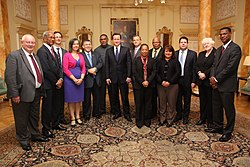
Leaders of the Overseas Territories with former Prime Minister David Cameron in 2012.

Tristan da Cunha on 6 February 2013, as seen from space. The population was temporarily evacuated to the UK in 1961 because of an eruption. Postal code TDCU 1ZZ
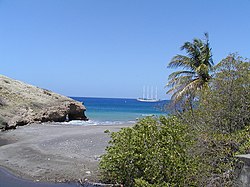
Coastline at Little Bay, the site of the new capital of Montserrat replacing Plymouth. The project is funded by the[45] UK's Department for International Development.
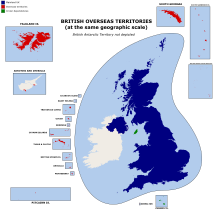
British Overseas Territories at the same geographic scale as the UK.
The Foreign and Commonwealth Office (FCO) has the responsibility of looking after the interests of all overseas territories except the Sovereign Base Areas of Akrotiri and Dhekelia, which comes under the jurisdiction of the Ministry of Defence.[46][47] Within the FCO, the general responsibility for the territories is handled by the Overseas Territories Directorate.[48]
In 2012, the FCO published The Overseas Territories: security, success and sustainability which set out Britain's policy for the Overseas Territories, covering six main areas:[49]
- Defence, security and safety of the territories and their people
- Successful and resilient economies
- Cherishing the environment
- Making government work better
- Vibrant and flourishing communities
- Productive links with the wider world
Britain and the overseas territories do not have diplomatic representations, although the governments of the overseas territories with indigenous populations all retain a representative office in London. The United Kingdom Overseas Territories Association (UKOTA) also represents the interests of the territories in London. The governments in both London and territories occasionally meet to mitigate or resolve disagreements over the process of governance in the territories and levels of autonomy.[50]
Britain provides financial assistance to the overseas territories via the Department for International Development. Currently[when?] only Montserrat and Saint Helena receive budgetary aid (i.e. financial contribution to recurrent funding).[citation needed] Several specialist funds are made available by the UK, including:
- The Good Government Fund which provides assistance on government administration;
- The Economic Diversification Programme Budget which aim to diversify and enhance the economic bases of the territories.
The territories have no official representation in the UK Parliament, but have informal representation through the All-Party Parliamentary Group,[51] and can petition the UK Government through the Directgov e-Petitions website.[52] Only Gibraltar has representation in the European Parliament and it shares its Member with the region of South West England.
Two national parties, UKIP and the Liberal Democrats, have endorsed calls for direct representation of overseas territories in the UK Parliament, as well as backbench members of the Conservative Party and Labour Party.[53][54][55][56]
Foreign affairs

Map showing the portion of Antarctica claimed by the UK as British Antarctic Territory.
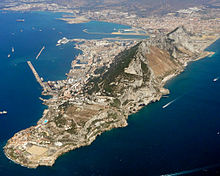
Gibraltar is the only overseas territory included in the European Union
Foreign affairs of the overseas territories are handled by the FCO in London. Some territories maintain diplomatic officers in nearby countries for trade and immigration purposes. Several of the territories in the Americas maintain membership within the Organisation of Eastern Caribbean States, the Caribbean Community, the Caribbean Development Bank, Caribbean Disaster Emergency Management Agency, and the Association of Caribbean States. The territories are members of the Commonwealth of Nations through the United Kingdom. The inhabited territories compete in their own right at the Commonwealth Games, and three of the territories (Bermuda, the Cayman Islands and the British Virgin Islands) sent teams to the 2008 Summer Olympics.
Gibraltar is the only overseas territory that is part of the European Union (EU), although it is not part of the European Customs Union, the European Tax Policy, the European Statistics Zone or the Common Agriculture Policy. Gibraltar is not a member of the European Union in its own right. The Sovereign Base Areas in Cyprus are not part of the European Union, but they are the only British overseas territory to use the euro as official currency. None of the other Overseas Territories are members of the EU, the main body of EU law does not apply and, although certain slices of EU law are applied to those territories as part of the EU's Association of Overseas Countries and Territories (OCT Association), they are not commonly enforceable in local courts. The OCT Association also provides overseas territories with structural funding for regeneration projects.
Since the return of full British citizenship[57] to most 'belongers' of overseas territories (mainly since the British Overseas Territories Act 2002), the citizens of those territories hold concurrent European Union citizenship, giving them rights of free movement across all EU member states.
Five nations dispute the UK's sovereignty in the following overseas territories:
British Antarctic Territory – Territory overlaps Antarctic claims made by Chile and Argentina
British Indian Ocean Territory – claimed by Mauritius and Seychelles
Falkland Islands – claimed by Argentina
Gibraltar – claimed by Spain
South Georgia and the South Sandwich Islands – claimed by Argentina
Citizenship
This section's tone or style may not reflect the encyclopedic tone used on Wikipedia. (February 2015) (Learn how and when to remove this template message) |
None of the overseas territories has its own nationality status, and all citizens are classed as British Overseas Territories citizens (BOTC). They do, however, have legislative independence over immigration, and holding the status of a BOTC does not automatically give a person a right of abode in any of the territories, as it depends on the territory's immigration laws. A territory may issue Belonger status to allow a person classed as a BOTC to reside in the territory that they have close links with. Non-BOTC citizens may acquire Belonger status to reside in a particular territory (and may subsequently become naturalised BOTC if they wish).
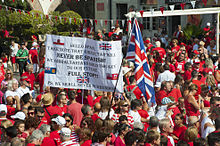
Thousands of Gibraltarians dress in their national colours of red and white during the 2013 Gibraltar National Day celebrations.
Historically, most inhabitants of the British Empire held the status of British subject, which was usually lost upon independence. From 1949, British subjects in the United Kingdom and the remaining colonies became citizens of the United Kingdom and Colonies. However changes in British immigration and nationality law between 1962 and 1983 saw the creation of a separate British Dependent Territories citizenship (BDTC) with effect from January 1983. Citizens in most territories were stripped of full British citizenship. This was mainly to prevent a mass exodus of the citizens of Hong Kong to the UK before the agreed handover to China in 1997. Exception was made for the Falkland Islands, which had been invaded in 1982 by Argentina. Full British citizenship was soon returned to the people of Gibraltar having regard to the friction with Spain.
However, the British Overseas Territories Act 2002 replaced British Dependent Territory citizenship with British Overseas Territories citizenship (BOTC), and restored full British citizenship to all BOTCs except those from Akrotiri and Dhekelia. This restored to BOTCs the right to reside in the UK.
British citizens, however, do not have an automatic right to reside in any of the Overseas Territories. Some territories prohibit immigration, and any visitors are required to seek the permission of the territory's government to live in the territory.
Military

RAF Mount Pleasant, Falkland Islands
Defence of the Overseas Territories is the responsibility of the UK. Many of the overseas territories are used as military bases by the UK and its allies.
Ascension Island (part of Saint Helena, Ascension and Tristan da Cunha) – the Base known as RAF Ascension Island is used by both the Royal Air Force and the United States Air Force.
Bermuda – became the primary Royal Navy base in America, following US independence. The Naval establishment included an admiralty, a dockyard, and a naval squadron. A considerable military garrison was built up to protect it, and Bermuda, which the British Government came to see as a base, rather than as a colony, was known as Fortress Bermuda, and the Gibraltar of the West (Bermudians, like Gibraltarians, also dub their territory "The Rock").[58] Canada and the USA also established bases in Bermuda during the Second World War, which were maintained through the Cold War. Four air bases were located in Bermuda during the Second World War (operated by the Royal Air Force, Royal Navy, US Navy, and US Army/Army Air Force). Since 1995, the military force in Bermuda has been reduced to the local territorial battalion, the Royal Bermuda Regiment.
British Indian Ocean Territory – the island of Diego Garcia is home to a large naval base and airbase leased to the United States by the United Kingdom until 2036 (unless renewed). There are British forces in small numbers in the BIOT for administrative and immigration purposes.
Falkland Islands – the British Forces Falkland Islands includes commitments from the British Army, Royal Air Force and Royal Navy, along with the Falkland Islands Defence Force.
Gibraltar – British Forces Gibraltar includes a Royal Navy dockyard (also used by NATO), RAF Gibraltar – used by the RAF and NATO and a local garrison – the Royal Gibraltar Regiment.- The Sovereign Base Areas of Akrotiri and Dhekelia in Cyprus – maintained as strategic British military bases in the eastern Mediterranean Sea.
Montserrat – the Royal Montserrat Defence Force, historically connected with the Irish Guards, is a body of twenty volunteers, whose duties are primarily ceremonial.[59]
Saint Helena – it has been speculated[60] that the new Saint Helena Airport might be used for military purposes but this has neither been confirmed nor denied.
Languages
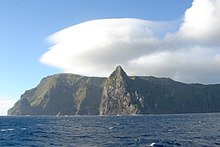
Cliffs at Gough and Inaccessible Islands.
Most of the languages other than English spoken in the territories contain a large degree of English, either as a root language, or in codeswitching, e.g. Llanito. They include:
Llanito or Yanito and Spanish (Gibraltar)
Cayman Creole (Cayman Islands)
Turks-Caicos Creole (Turks and Caicos Islands)
Pitkern (Pitcairn Islands)
Greek and Turkish (Akrotiri and Dhekelia)
Forms of English:
Bermudian English (Bermuda)- Falkland Islands English
Currencies
The many British overseas territories use a varied assortment of currencies, including the euro, pound, US dollar, NZ dollar, or their own currencies, which may be pegged to one of these.
| Location | Native currency | Issuing authority |
|---|---|---|
| Euro | European Central Bank |
| Pound sterling | Bank of England |
| Falkland Islands pound (parity with pound sterling) | Government of the Falkland Islands |
| Gibraltar pound (parity with pound sterling) | Government of Gibraltar |
| Saint Helenian pound (parity with pound sterling) | Government of Saint Helena |
| United States dollar | US Federal Reserve |
| Eastern Caribbean dollar (pegged to US dollar at 2.7ECD=1USD) | Eastern Caribbean Central Bank |
| Bermudian dollar (parity with US dollar) | Bermuda Monetary Authority |
| Cayman Islands dollar (pegged to US dollar at 1KYD=1.2USD) | Cayman Islands Monetary Authority |
| New Zealand dollar | Reserve Bank of New Zealand |
| United States dollar (de facto)[63][64] | US Federal Reserve |
1 Part of the British Overseas Territory of Saint Helena, Ascension and Tristan da Cunha.
Symbols and insignia
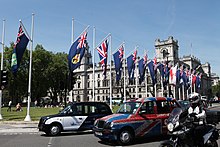
Overseas Territories flags in Parliament Square in 2013
Each overseas territory has been granted its own flag and coat of arms by the British monarch. Traditionally, the flags follow the Blue Ensign design, with the Union Flag in the canton, and the territory's coat of arms in the fly. Exceptions to this are Bermuda which uses a Red Ensign; British Antarctic Territory which uses a White Ensign; British Indian Ocean Territory which uses a Blue Ensign with wavy lines to symbolise the sea; and Gibraltar which uses a banner of its coat of arms (the flag of the city of Gibraltar).
Akrotiri and Dhekelia and Saint Helena, Ascension and Tristan da Cunha are the only British overseas territories without their own flag. The Union Flag is used in these territories.
Sports
Bermuda, the British Virgin Islands and the Cayman Islands are the only British Overseas Territories with recognised National Olympic Committees (NOCs); the British Olympic Association is recognised as the appropriate NOC for athletes from the other territories, and thus athletes who hold a British passport are eligible to represent Great Britain at the Olympic Games.[67]
Shara Proctor from Anguilla, Delano Williams from the Turks and Caicos Islands, Jenaya Wade-Fray from Bermuda[68] and Georgina Cassar from Gibraltar strived to represent Team GB at the London 2012 Olympics. Proctor, Wade-Fray and Cassar qualified for Team GB, with Williams missing the cut, however wishing to represent the UK in 2016.[69][70]
The Gibraltar national football team was accepted into UEFA in 2013 in time for the 2016 European Championships. It has been accepted by FIFA and went into the 2018 FIFA World Cup qualifying, where they achieved 0 points.